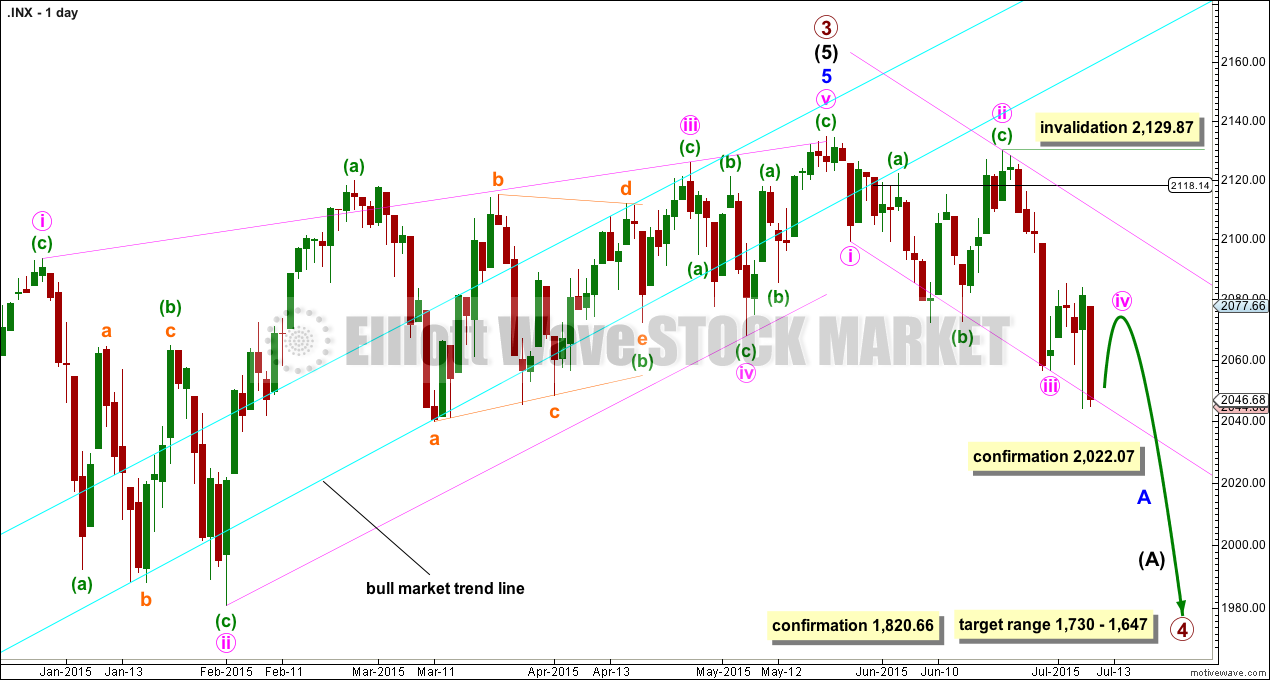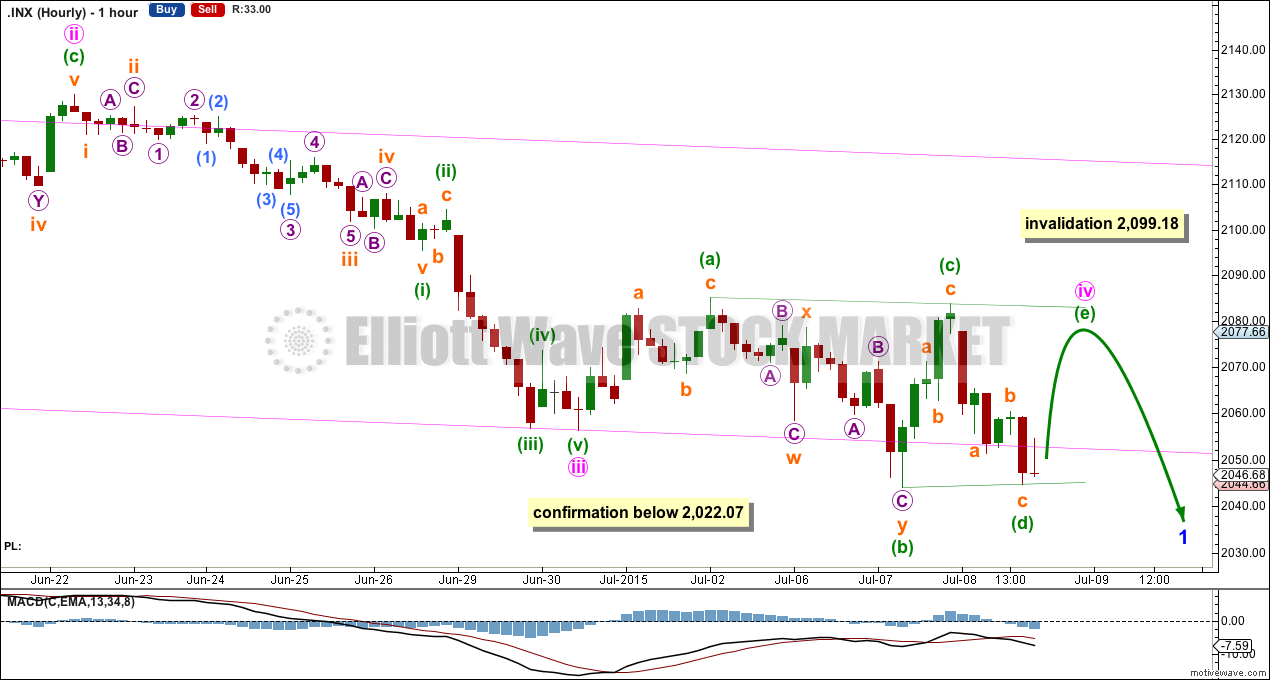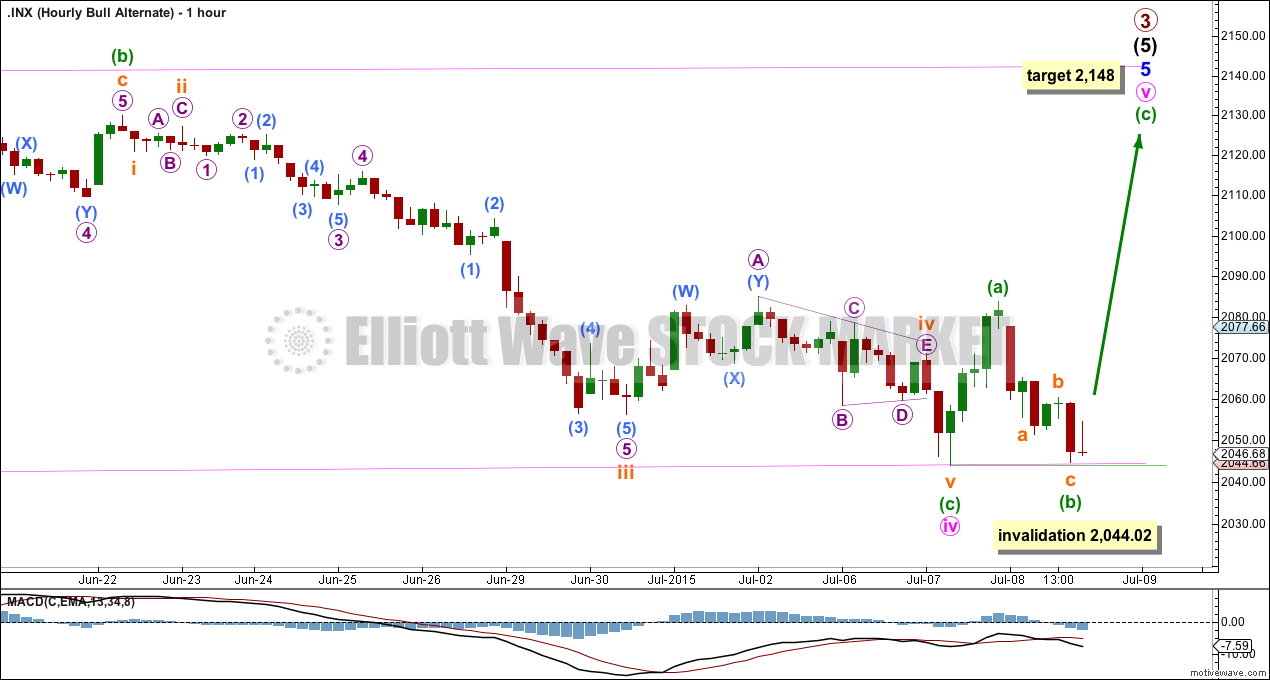Downwards movement was expected for the alternate Elliott wave count, but not the main.
Price remains above the invalidation point on the main Elliott wave count and below the invalidation point on the alternate.
Summary: There is now clearly a close more than 3% of market value below the bull market trend line that goes back to 2011. There is enough confirmation for the main wave count to now expect the S&P is in a bear market. A fourth wave correction should complete shortly, to be followed by more downwards movement.
To see a weekly chart and how to draw trend lines go here.
Changes to last analysis are bold.
MAIN ELLIOTT WAVE COUNT
It is possible that the S&P has seen a primary degree (or for the bear count below a Super Cycle degree) trend change.
This wave count now has some confirmation at the daily chart level with a close more than 3% of market value below the long held bull market trend line.
Further confirmation would come with:
1. A new low below 2,022.07 to invalidate the alternate wave count.
2. A clear five down on the hourly chart.
3. A clear five down on the daily chart.
4. A new low below 1,820.66.
As each condition is met the probability of a substantial trend change would increase.
Primary wave 4 would most likely be a time consuming flat, triangle or combination in order to exhibit structural alternation with the zigzag of primary wave 2. Primary wave 2 lasted 12 weeks. Primary wave 4 is likely to be longer in duration because combinations and triangles particularly are more time consuming than zigzags which tend to be quick corrections. Primary wave 4 may be expected to last more than 12 weeks, and may end with a total Fibonacci 13 or more likely 21 weeks.
At this stage, a trend change is looking somewhat likely so I’ll list points in its favour:
1. ADX is above 20 and rising, and the -DX line is above the +DX line indicating a new downwards trend.
2. The long held bull market trend line, the strongest piece of technical analysis on ALL charts, has been breached now by a close more than 3% of market value.
3. There is quadruple negative divergence between price and MACD on the weekly chart.
4. There is double negative divergence between price and MACD on the daily chart.
5. There is persistent and strong negative divergence between price and RSI on the monthly chart. The last time this happened was October 2007 and we all know what happened after that…
6. A long held bull trend line on On Balance Volume going back to October 2014 has been breached and is no longer providing support.
7. Nasdaq recently made new all time highs. Only DJT now is required to make a new all time high to confirm continuation of a bull market. Failure of DJT to confirm the bull market does not mean a bear market exists and just indicates caution.
Sideways movement is either a fourth wave correction, which may not move back into its counterpart first wave price territory above 2,099.18, or it is another second wave correction within minute wave iii, which may not move beyond the start of minute wave iii above 2,129.87. If price moves above 2,099.18, then the invalidation point moves up to 2,129.87.
The most likely fourth wave correction so far looks like it may be completing as a running contracting triangle. Minuette wave (e) of the triangle may not move beyond the end of minuette wave (c) above 2,083.74. If price moves above 2,083.74, then this fourth wave may be morphing into a double combination: zigzag – X – flat.
The fourth wave may end tomorrow with a little upwards movement. Thereafter, a final fifth wave down should be ready to begin.
ALTERNATE ELLIOTT WAVE COUNT
The ending contracting diagonal may still be incomplete. Ending diagonals require all sub waves to subdivide as zigzags, and the fourth wave should overlap first wave price territory. It is Elliott wave convention to always draw the diagonal trend lines to indicate a diagonal structure is expected.
The diagonal trend lines are no longer clearly contracting and minuette wave (c) within minute wave iv now looks like a three where it should be a five. This reduces the probability of this wave count.
If it moves any lower, then minute wave iv may not be longer than equality in length with minute wave ii at 2,022.07. If it is over here, then minute wave v up also has a limit and may not be longer than equality with minute wave iii at 2,197.84.
The best way to see where and when upwards movement may end is the upper diagonal i-iii trend line. It is very likely to be overshot. Upwards movement may find resistance at the long held bull market trend line.
Because the long held bull market trend line has now been breached by a close more than 3% of market value below it, this wave count is now an alternate and a bear market is indicated.
Minute wave v may have begun with either minuette waves (a) and (b) complete, or only subminuette waves i and ii within minuette wave (a) complete. The degree of labelling within minute wave v may be correct here, or it could also be moved down one degree.
At this stage, if minuette waves (a) and (b) are complete, then at 2,148 minuette wave (c) would reach 2.618 the length of minuette wave (a).
I don’t have a lot of confidence in this target. When there is more structure upwards to analyse then the target may change, but it does not expect a reasonable overshoot of the i-iii diagonal trend line.
At this stage, I also don’t have confidence in this alternate wave count: the diagonal is not looking right at the daily chart level, ADX continues to indicate a downwards trend is in place, and volume continues to favour a bear market.
BEAR ELLIOTT WAVE COUNT
The subdivisions within cycle waves a-b-c are seen in absolutely exactly the same way as primary waves 1-2-3 for the main wave count.
In line with recent Grand Super Cycle wave analysis, I have moved the degree of labelling for the bear wave count all up one degree.
This bear wave count expects a Super Cycle wave (c) to unfold downwards for a few years, and if it is a C wave it may be devastating. It may end well below 666.79.
However, if this wave down is a Super Cycle wave (y), then it may be a time consuming repeat of the last big flat correction with two market crashes within it, equivalent to the DotCom crash and the recent Global Financial Crisis, and it may take another 8-9 years to unfold sideways.
Within the new bear market, no second wave correction may move beyond the start of its first wave above 2,134.72.
TECHNICAL ANALYSIS
Finally a close more than 3% of market value below the long held bull market trend line allows me to cautiously expect the S&P500 is in a new bear market.
ADX still indicates a new downward trend is underway. Light volume for Wednesday indicates today was maybe part of a smaller correction and not a motive wave down. This supports the main hourly wave count which sees a small fourth wave incomplete, and is a warning that tomorrow price may move higher for a green candlestick.
Overall volume is declining from a strong down day on 26th June while price falls. A small correction currently unfolding could explain this in the short term, and will be correct if this decline in volume is halted by another strong down day.
The long held divergence between price as it made its final all time high and On Balance Volume moving lower supports the main wave count. It is an indication that this downward trend may be deeper and longer lasting than recent downward corrections have been.
A note on Dow Theory: for the bear wave count I would wait for Dow Theory to confirm a huge market crash. For that to be confirmed the following new lows are needed:
S&P500: 1,820.66
Nasdaq: 4,116.60
DJT: 7,700.49
DJIA: 15,855.12
At this time DJT is closest, but none of these indices have made new major swing lows yet.
Google has a “forever” trend line which began at its IPO in 2004. This trend line is not just long held; it is held for the lifetime of this equity, is somewhat shallow, and has been repeatedly tested. If the trend line is breached, then that would be significant for Google, and it may be a leading indicator for the stock market as a whole.
Very interestingly Google this week is sitting right on that trend line.
The decline in volume towards all time highs for Google indicates a weakening in this upward trend.
This analysis is published about 09:14 p.m. EST.







